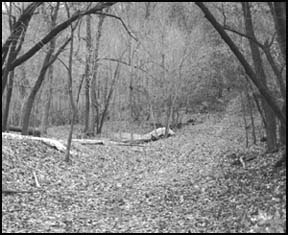 Neighbors near the Veteranís Memorial Park on Lake Koronis became concerned when they heard chain saws buzzing at the park.
Neighbors near the Veteranís Memorial Park on Lake Koronis became concerned when they heard chain saws buzzing at the park.They saw crews cutting large amounts of underbrush and trees from the thick woodland area in the park.
Tom Koshiol, park board member, said, ďWe understand it is difficult to watch and hear the current cutting taking place. While it is taking place, keep in mind that it is our intent to create a forest of lasting beauty and value for the people of the area to enjoy and that we also want to improve the forestís long-term value to the environment, as well as to wildlife species. Within the next two years we will begin to notice positive changes to the woodland.Ē
Work started in July to make the nature trail more accessible to the public at the Veteranís Memorial Park. The trail has been in existence for years, but seldom used because it had become overgrown.
The 10-acre woodland is located on the eastern edge of Lake Koronis. The Department of Natural Resources (DNR) is overseeing the project. Jeff Haas, DNR forester, inspected the trees and marked which ones were beneficial to restore the forest of the park and which ones were not.
ďWork on the project is being carried out by community service crews from the Stearns County Department of Human Services,Ē Ron Mergen, public works director, said. ďHopefully, work will be completed by spring. The mosquitoes slowed down the project this summer.Ē
The definition of the term ďrestoreĒ is to bring something back to a former or normal condition. ďFor this forest, that is the condition it was prior to the 1850s. Our intent is that its tree, shrub and herb layers would return back to the Big Woods Hardwood Forest community it was prior to 1850,Ē Mergen said.
The current condition of the woodland is not good, according to Mergen. It is a classic example of the degeneration that has taken place in state forests over the past 140 years.
The process of forest restoration begins with the removal of the undesirable plants and trees. Following this, the cut stumps are treated to prevent regrowth. Ironwood trees and prickly ash, tough native species, are being removed because they are unwelcome due to their invasive tendencies.
ďIt is also necessary to thin thickly growing young trees by selectively cutting them, leaving only the hardiest, straightest, and strongest saplings to grow. We do plan to leave some dead trees, down and standing, to attract woodpeckers and other birds, and to complete their cycle of decay and soil replenishment,Ē Koshiol added.
Following the removal of the non-native plants, the process of replanting begins. The soils in the area have a high potential for surface run-off, making it erosion prone. This can cause a high mortality rate for seedlings. Therefore, some native ground cover will be restored for the long-term health of the woodland. Since regeneration of native trees has been diminished over the years, some areas have scant tree top vegetation. It is here that seedlings will be planted in protective biodegradable tubes. As the trees become established, the tubes will break down and become incorporated into the soil.
Another change to the park area will be that control burns in the future will help control the growth of unwanted plants and brush. The lack of wildfires that once swept periodically through the area has allowed the area to become overgrown. Non-native species, because of their shallow root systems, succumbed more easily to fire than deep-rooted native species.
Linda Liestman, a concerned citizen promoting the project, said with the advancement of civilization in the 1850s, several detrimental changes were brought to the forests. One most significant change was the introduction of non-native plants. Many of these plants were invasive, that is, it was easy for them to grow outside the intended confined areas (garden or field) and to naturalize in woodlands and prairies. Consequently, our forests today are literally choked with non-native species such as buckthorn and Japanese honeysuckle.
Ninety percent of our forests were destroyed by development. In studying old vegetation maps, this is also true for the Lake Koronis area. This high level of forest loss left ďpostage stampĒ pieces remaining. The park parcel is such a piece.
Forest parcels are important for these reasons:
ē High density of leaves cleans the air and cools nearby surface waters, helping to keep them clean.
ē The deep, high-density root systems of native plants control erosion and slow surface water run-off, thus helping regenerate clean ground water supplies.
ē Forests provide habitat for wildlife and are important to the enjoyment of people who walk in them or just observe their scenic beauty from afar.